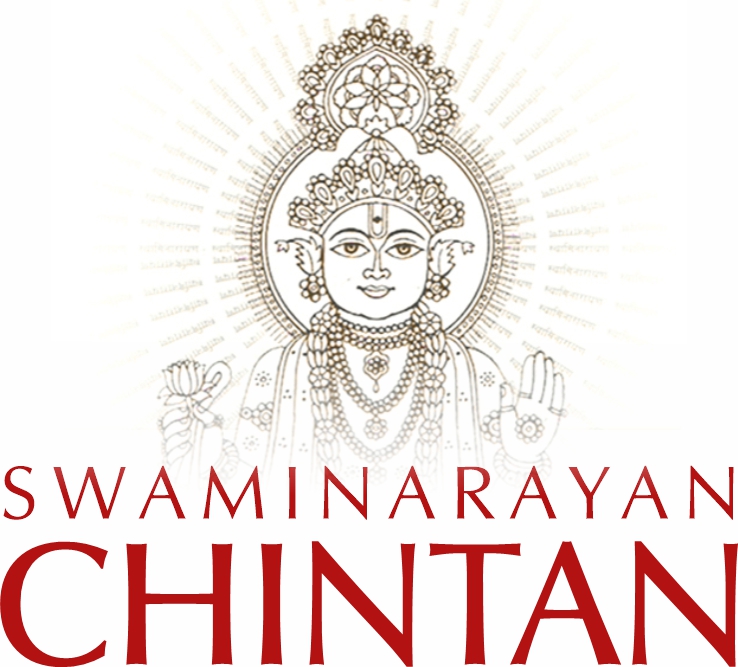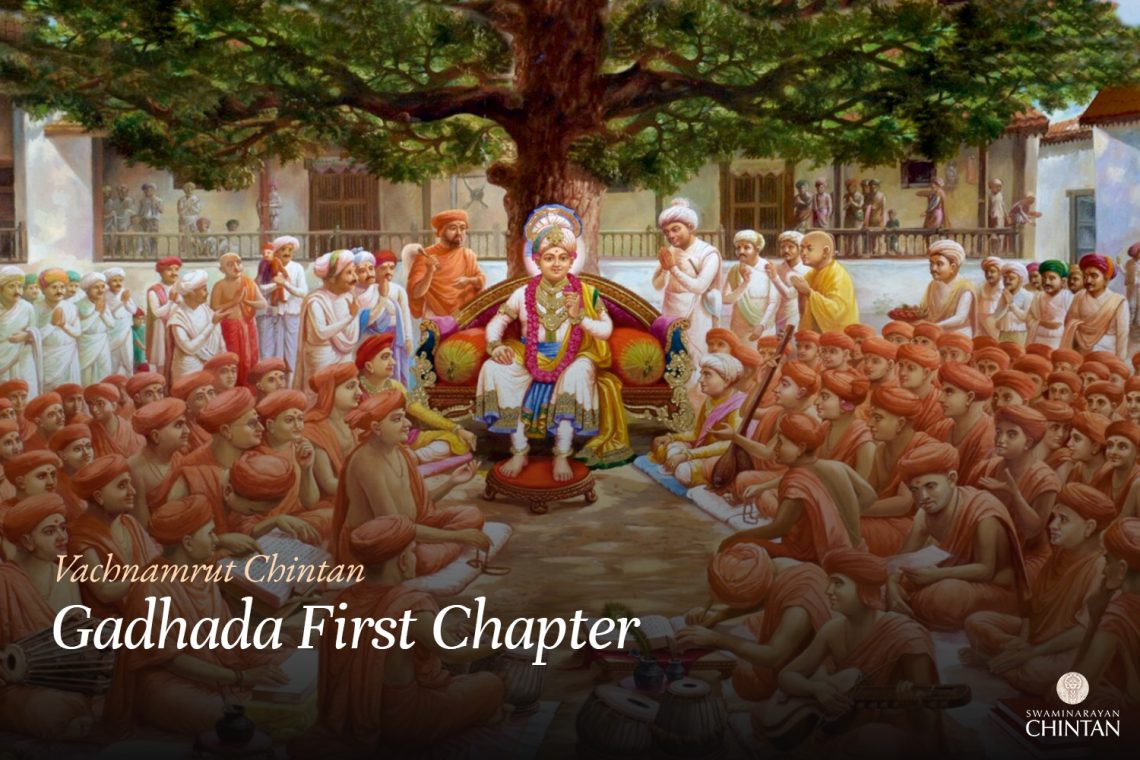Central Insights:
- What causes one to progress or regress in Satsang?
Key Points:
- One who imbibes the virtues of a Sadhu continues to progress day by day.
- One who focuses on the faults of a Sadhu continues to
regress day by day.
Discussion:
This Vachanamrut addresses the reasons for spiritual growth and decline within the fellowship of Satsang. Shreeji Maharaj reveals who moves forward and who falls back on the path to kalyan (liberation). Inspired by Maharaj’s encouragement to pose questions, Muktanand Swami asks: Why is it that some individuals, despite staying in Satsang, continuously progress, while others steadily regress?
Shreeji Maharaj replies: One who observes the faults of senior Sadhus begins to decline, whereas one who focuses on their virtues flourishes. Therefore, one should refrain from finding faults in a Sadhu and instead draw only from their virtues. A Sadhu may only be deemed at fault if he violates one of the panch vartaman (five moral vows of sant) established by God. But if his temperament appears disagreeable, while his conduct remains within the bounds of the vartaman, such impressions should not be considered faults.
Sadguru Gunatitanand Swami elaborates: Three qualities foster growth—virtue (gun), humility (vinay), and service (seva). In contrast, stubbornness (hath), ego (man), and jealousy (irshya) are causes of regression. Swami adds that while some gain spiritual knowledge (gyan) and thereby ascend, others grow more egoistic and thus descend. Therefore, learning and embodying the virtues of God’s devotees is the path to spiritual advancement. However, acquiring virtues can also give rise to subtle pride. Hence, humility is essential. When one’s virtues are coupled with humility, they become genuinely valuable. To crown this, Shreeji Maharaj advises serving God’s devotees with mind, actions, and speech.
In summary, if one sincerely desires spiritual progress— especially on the path of kalyan—then wholehearted service to God’s devotees is indispensable.
On the other hand, three traits cause downfall: stubbornness, ego, and jealousy. Opposing a devotee of God or engaging in conflict with them brings ruin, as seen in numerous scriptural accounts— Hiranyakashipu, Kamsa, Ravan, Ramandalik, and within the Swaminarayan tradition, Raghunathdas and Nirvikalpanand. In each case, their downfall was rooted in enmity toward the devotees of God.
Therefore, one must not hold on to stubbornness toward a devotee of God. Instead, surrender, humility, and yielding are essential. Pride inevitably leads to a need to defend one’s status, which fosters stubbornness and eventually breeds jealousy. Only by being humble can one truly move forward. Without humility, progress is halted.
In this Vachanamrut, it is stated that one either progresses or regresses based on whether they perceive virtues or flaws in senior sadhus. Interestingly, it is not merely “a true sadhu” but specifically “a senior sadhu” (mota sant) that Maharaj refers to— intentionally so. This is meaningful, because besides embodying the ideal of renunciation, such leaders also carry special administrative and social responsibilities within a mandir, society, or sankul. These additional roles often present situations where their faults may become more easily apparent.
However, this does not imply that whatever a senior does is automatically correct, nor does it mean one should never perceive any faults. Maharaj clearly outlines when it is appropriate to acknowledge a fault—only when there is a transgression of the panch vartaman. By doing so, he sets a clear boundary and framework. A person who is inclined to notice faults will see them everywhere— but this does not mean that there are no real shortcomings in seniors.
The central message of this Vachanamrut is not to discern whether virtues or faults exist in a person. Rather, the intent is to guide us toward progressing or regressing on the path of Satsang. One may argue: “But what if there truly is a fault in the senior? If I acknowledge it, what wrong am I doing?”—and indeed, such a point may be valid. You may not be doing anything wrong at that moment. Yet, Maharaj’s teaching is not simply about identifying truth or falsehood—it is about what influences your own spiritual ascent or descent. Even if a flaw truly exists, unless it crosses the bounds defined by the panch vartaman, one should still focus on virtues.
Moreover, a senior sadhu not only carries personal responsibility but also bears the burden of guiding the progress of the broader Satsang community. Recognizing such responsibilities and appreciating their virtues furthers one’s own development. The Vachanamrut also outlines how to distinguish between virtue and fault, and under what context each should be noted. It insists that as long as a person stays within the bounds of the panch vartaman, even if their temperament does not resonate with ours, we must still perceive their virtues, not their faults. If they do breach moral boundaries, we are instructed to maintain distance, but not to dwell mentally on their flaws.
What does it mean to “see a virtue”? When is a virtue truly seen? And when is a fault truly seen? Even in the most elevated santos, there may be some human imperfection—because perfect personality is Paramatma alone. If we are emotionally attached to a person, even if we are aware of their flaws, our intellect will grasp only their virtues. For instance, even when a child has negative traits, the parents instinctively highlight the good—because their hearts are bound by affection. Love leads the mind to catch virtues first.
Likewise, when we are prejudiced—perhaps harboring jealousy, aversion, or resentment toward someone—then even if that person has many virtues, our minds will latch onto their faults. In such a state, we are said to have “taken their fault.” Not because the fault is dominant, but because our own internal bias overrides our ability to see their goodness. Conversely, when we are able to identify virtues despite imperfections, that is “taking virtue.”
Therefore, gun levo (taking virtue) and avagun levo (taking fault) are not about making a purely objective assessment. Rather, they reflect an internal disposition: how we engage with the perceived qualities of devotees. It is a spiritual process—what we see, absorb, and allow to influence our spiritual trajectory.
Glossary
| Satsang – Association with saints and devotees of God The highest means of liberation, considered even greater than yog, tapas, and rituals |
| Kalyan – Ultimate liberation or salvation The highest spiritual goal – freedom from the cycle of birth and death. |
| Panch Vartaman – Five sacred vows of santos Nirlobh (Greed-free living), Nishkam (Lust-free living), Nihswad (Taste-detached living), Nihsneh (Attachment-free living), Nirman (Ego-free living) |
| Gun levo – Taking virtues The quality of observing and imbibing good traits of others, especially of God and His devotees |
| Avagun levo – Finding faults A spiritually harmful tendency to focus on the faults of santos or devotees. |
| Hath – Egoistic obstinacy A stubborn, pride-driven attitude that impedes spiritual progress. |
| Man – Mind |
| Irshya – Jealousy |
| Gyan – Spiritual knowledge Realization of God’s greatness and soul’s true nature. |
| Seva – Service |
| Vinay – Humility Modesty and respect in behavior, especially toward santos and God. |
| Sankul – Institute or Organization |

